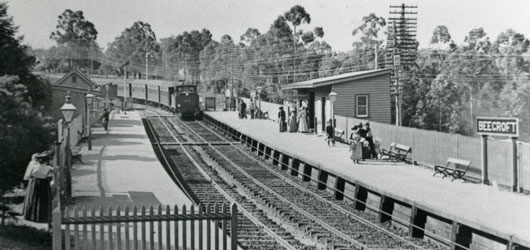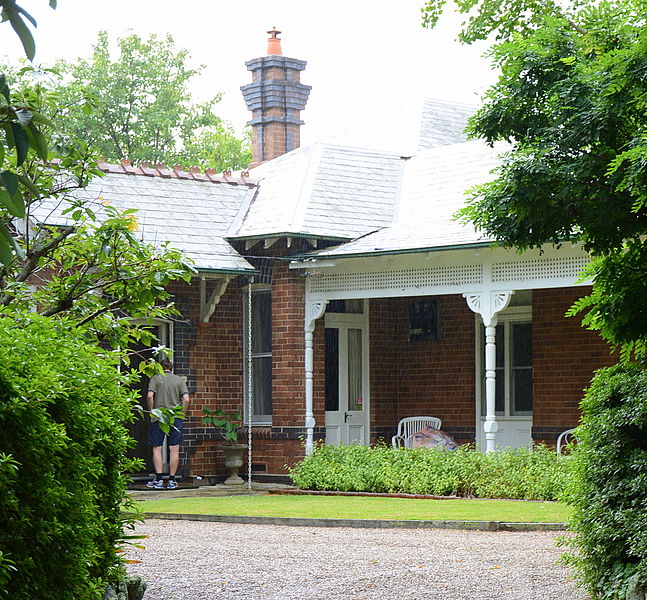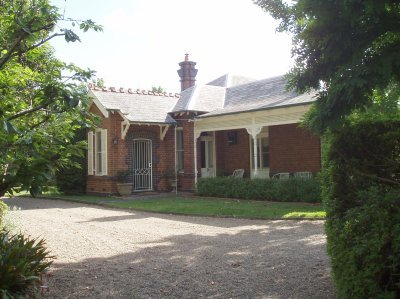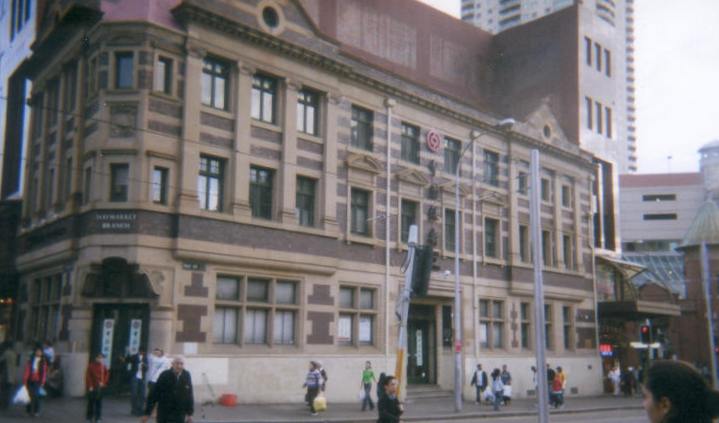NSW Federation Architect William Mark Nixon
[Previous Post: National Trust Tasmanian Heritage Register 12 .... Next Post: Deltroit Station, Gundagai NSW]
 |
| William Mark Nixon |
The elder William arrived in Australia with £30,000 from the family woollen mills but lost most of it in gold mining investments.
- His son, William Mark Nixon, began work in the Colonial Architect’s Office and later the Department of Railways, and in 1893, despite the depression and having only £30 of savings, he set up his own architectural practice in Pitt Street, Sydney.[1]
- In 1886 he married Ada Fox of Tumut, daughter of an Anglican clergyman.
- They had five sons, four living to adulthood: William E. (born 1887), Charles A. (born 1889) George (born 1890) and Allen D. (born 1893).
- They lived for a few years in Ashfield but moved to Beecroft in the hope that the higher altitude and open space would improve Allen’s asthmatic condition.
 |
| Kunaware, 11 Malton Road BEECROFT NSW |
In 1904 William purchased three lots on the southern side of Malton Road and erected ‘a magnificent new villa residence’ to his own design.'Lynwood' was of brick and tile, of the new ‘Federation’ style with a sunny north-eastern corner bay.
- The first three boys attended Beecroft Public School and later Newington College.
Allen went to live in Gocup near Tumut for his health.[2] - By 1910, as William Jr. and George were living in the country and only Charles lived at home while working with his father as an architect, the Beecroft house was too large for the smaller family.
| 12 Malton Road Beecroft – Lynwood | 11 Malton Road Beecoft – Kunaware | ||||||||
|---|---|---|---|---|---|---|---|---|---|
| 
|
- It was of individual style with a slate roof and timber trims on stuccoed walls surrounded by a beautiful garden.
- The third house was named ‘Lynwood’ after the Nixon family home in Hawick as were the previous two Sydney homes.[3]
William Nixon was President of Hornsby Shire in 1908 and 1909, having been President of the Beecroft Progress Association the year after he made his home in the suburb.
- He was foundation President of the Parents’ and Residents’ Association,
- a committee member of the Literary and Debating Society and the Musical and Dramatic Society,
- a trustee of the Recreation Ground and
- a sidesman of St John’s Church in 1913.

As often happens with such people who are active and vocal in local committees, William Nixon had differences of opinion with his committee friends. After a long discussion in 1917 about the site of the proposed Honour Board to local servicemen, the Cumberland Argusreporter wrote:
- ‘There are two Mr. Nixons – one is a bluff, gruff and blustersome individual who annoys people and who will persist in trying to force his will on others when he knows he is wrong and unreasonable.
- The other Mr. Nixon is a really good-hearted fellow, a capital worker and a really fine citizen, but he is so very shy and retiring that he only presents himself to intimate friends.’[5]
- Ada Nixon was a committee member of St John’s Church and for many years ran a Bible Class for young men in her home, William having built a large veranda on the back of the house for these meetings. She was remembered as a very kind lady with a deep religious faith.
Many of the solid, well built homes of Beecroft and Cheltenham were designed by William Nixon, in various styles according to their owners’ taste.
- Some were of a conservative plan of the traditional central passageway,
- others were in the ‘//Arts and Crafts//’ style, with both internal plan and external details of modern fashion.
- The two houses he built in Malton Road were interesting architecturally.
Before coming to Beecroft he had had wide experience in house design of the ‘Queen Anne’ style (or ‘Federation’ as it came to be known later).
- He also designed the Presbyterian Church in Waverley,
- the large South African War Memorial in Gundagai in 1900,
- the Crago flour mills in Newtown,
- additions to the Soup Kitchen in Kent Street, Sydney,
- a terrace of five houses in Darlinghurst,
- a drill hall in Randwick and
- a new ward at the Western Suburbs Hospital.
- In 1918 Charles Nixon enlisted to join his brothers George and Allen already with the Australian Imperial Force in France where George had been badly gassed.
- In April 1918, George was awarded the French Croix de Guerre.
- On 24 September 1918, Lieutenant Charles Nixon, who served with the 4th Brigade, Australian Field Artillery, died of wounds.
- For many years afterwards Ada Nixon would hear the roar of guns in a thunderstorm, bringing back memories of her dead son.[8]
Renovations reveal beauty of 100-year-old Beecroft homeFeb 22, 2015: Trisha CroakerOwners Glenys and Stephen Rowe, working with architect and heritage specialist Hector Abrahams, have spent more than 10 years gradually, one small project at a time, improving the liveability of their 100-year-old home, Lynwood. Lynwood, the two-storey brick home by architect William Nixon, who also designed the Centennial Park home later owned by Patrick White, was purchased unaltered except for an unsympathetic 1980s kitchen makeover. Hector’s approach was to strip away the 1980s and expose the beauty of the original. False ceilings were removed and old ceiling heights restored; all plasterboard linings were removed to expose gorgeously textured, painted brickwork; floor tiles were torn up to reveal the original kauri floorboards.  | “This is still the service wing of the house, and it was important it has a utilitarian feel.” Floors and windows were reconfigured, and a steel-framed bay window and daybed inserted: ensuring maximum light into the east-facing room and improved access to the garden. He then developed the concept of a kitchen as “furnished room – one big furnished room for eating, cooking, reading, living”.  “The cupboards are pieces of furniture for Glenys collection, the fridge and pantry are designed as pieces of furniture, the bookcases.” And, to finish it off, Glenys’ love for colour was reflected in her choice of a strong pumpkin shade for the working kitchen cupboards, and a complementary deep blue for all “collecting” cupboards and cabinetry. |
 |  |
- William retired from architectural work when he was nearly 70 years old and died two years later in 1931.
- Ada Nixon remained in Beecroft with her sister-in-law for two or three years and on the latter’s death sold the house and moved to North Sydney and later Balgowlah. She died in Balgowlah about 1947.[9]
Section 2. Items listed under the NSW Heritage Act.
Your search returned 2 records.
Cossington 43 Ku-ring-gai Avenue Turramurra
(01763) |
| Cossington 43 Ku-Ring-Gai Avenue Turramurra NSW |
 |
| ||||
| Cossington, 43 Ku-Ring-Gai Avenue, Turramurra, NSW | Grace Cossington Smith portraits | ||||
|
|
Cossington is also of local heritage significance -
- for its unusual timber-lined meeting room originally used for Quaker meetings,
- for its associations with Cossington Smith's eminent lawyer father Ernest Smith,
- for its architectural qualities as a Federation bungalow designed by Nixon & Allen,
- and for its garden contributing to the streetscape.
"I am not sure there is another artist in the entire history of Australian art for whom there can be the same two-fold association of firstly, a house in which the artist lived for entirety of a career - more than six decades - and secondly, where the interior structure itself - ie the rooms inside - formed the basis of subject matter pursued with magnificent and profoundly spiritual dedication over that time."
(Barry Pearce, 2006)
Patrick White House, The, 20 Martin Road Centennial Park
 |
| Patrick White was an Australian writer |
"Highbury" (01719)
 |
| Patrick White house Centennial Park NSW |
The house, built in 1913, represents an example of a Federation bungalow designed by the prominent Sydney architect, William Nixon, which forms part of the planned, high quality residential precinct of Centennial Park from the Federation era. The building also represents a fine example of modern 1960s interior conversion.
- 20 Martin Road is of outstanding significance for its long-standing association with the leading Australian author, Patrick White, and his books.
- Patrick White is widely regarded as Australia's most celebrated and most famous author, and remains Australia's first and only recipient of the Nobel Prize for literature.
- Patrick White was remarkable not only for his international recognition, but for his originality for the time in his portrayal and pride in the Australian way of life, Australian landscape and Australian history that in the words of the Nobel Prize citation introduced a "new continent" to world literature, as well as a new perspective on national identity for many Australians.
The house, interiors and gardens provide a rare and remarkably intact record of the writing environment, lifestyle, inspiration, tastes, activities and interests of Patrick White at the peak of his career from 1964 until his death in 1990.
Section 3. Items listed by Local Government and State Agencies.
Your search returned 16 records.
Bank of China Including Interior 681 George Street Haymarket
The Bank of China, formerly the Savings Bank of New South Wales, is a three storey building of Federation Free style located on a prominent corner within the National Trust's Haymarket Conservation Area.It has historic significance as an important building in the professional work of the noted architect J B Adam.
- Designer/Maker: Nixon & Adam (J Sheldon)
- Builder/Maker: J C Harrison & Son
- Construction years: 1904-1904
 |
| 681 George Street, Haymarket, Sydney in 2006 |
Boer War Memorial 161 Sheridan Street Gundagai
| Boer War Memorial : 10-July-2011 |
The Gundagai Boer War Memorial demonstrates the skills of Messrs Nixon and Adam, architects, who designed it and Messrs Ross & Bowman, sculptors and stonemasons, who fabricated the monument in Carrara Marble in 1903.
- Designer/Maker: Nixon and Adam, Sydney Architects
- Builder/Maker: Ross And Bowman, stonemasons and sculptors of Waverley
Cragos Flour Mill 1 Gladstone Street Newtown
A fine example of a large city mill, built during a period of rationalisation of the milling industry. Its location in close proximity to the city and major transport arteries, with rail access and a private siding, reflects the economic forces affecting the industry at the time of its construction.
 |
| crago flour mill exterior view from street ,heritage conversion |
Former Savings Bank of NSW Including Interiors 11 Barrack Street Sydney
The Commonwealth Bank Building, formerly Savings Bank of NSW, is a four storey stone building of Victorian Academic Classical style constructed in three stages. It is located fronting Barrack Street formerly Barrack Square. It has high historic significance as the first Savings Bank in Australia and has continued in use as a bank. The building has historical significance as an important work in the professional careers of mid-nineteenth century architect Henry Robertson and of noted architect George Allen Mansfield, principal of the firm Mansfield Bros.Red East 1 Murray Road Beecroft
Unusually designed Federation period house on large corner site. Designed by William Nixon.Red East
- This land was first purchased by James Lawson in 1888. He sold it in 1913 to William Henry Price, who was a city fruit merchant.
- Price then on-sold in the same year to Eleanor Frances Pines (1869-1947) the widow of Frederick Pitt Pines (1839-1901) who had been chief manager of W H Paling & Co the music company. She built the property and remained there until her income from shares in W H Paling failed in the Great Depression.
- She sold the house in 1931 to Ida Gertrude Taylor wife of Arthur Bernard Taylor. One of her sons, Cleveland, married Jean a daughter of the nearby home Jenambe.
 |  |
 |  |
- A Federation period house on a large corner site. Complex slate roof. Walls now fully rendered in roughcast.
- Main frontage to the Crescent. Stone piers to entry. Open verandah. Large shingled gables.
- Original door with leadlight sidelights and highlight. Post and rail fence with hedge obscuring views of house.
- Sale listing and photographs
- "This extremely rare landmark property is brilliantly positioned over two lots comprising 2485sqm of park like grounds and gardens."
- "Steeped in local history and truly a magnificent residence, boasts amazing space and grace seldom found."
- Enormous ceiling heights and large glass areas throughout really let the sun shine in. You will just adore the intricate leadlight feature windows with beautiful built in seating."
House and Garden 151 Copeland Road Beecroft
 |
| 151 Copeland Road Beecroft |
- Designer/Maker: William
- Builder/Maker: Nixon
- Historical notes: Built in 1905. The architect was William Nixon.
- Part of a row of 8 houses (Nos 149-163) developed by George Sargent (of Sargents Pies).
Illanscourt 37 Ku-ring-gai Avenue Turramurra (1898)

A federation villa which relates well to other houses within the Ku-ring-gai Avenue Conservation Area.
The planning of the house features rooms which can be opened to form a large space for Quaker meetings.
Single storey red brick construction with slate roof.
Tall brick chimneys with elaborate strap work.
Cast iron verandah supports not original (National Trust).
Jenanbee 5 The Boulevarde Cheltenham
| Property photo of 5 The Boulevarde Cheltenham NSW 2119 |
Large Federation Bungalow style house with unusual shingled skirt which forms hood over bay windows. Designed by William Nixon. Good condition and little altered.
- Federation Bungalow style house circa 1920. Complex terracotta tiled roof with large shingled gables. Unusually wide shingled skirt carries out to form hood over front bay windows.
- Shingles to aprons of bays as well. Exposed rafter eaves and simple eaves brackets.
- Gables also feature louvred vents.
- Roughcast walls with face brick below sill ledge.
- Building partly obscured by high hedge.
Kunaware and Garden 11 Malton Road Beecroft
This home was designed by William Nixon as his family home, after his earlier home in Beecroft (‘Lynwood’) became too large. In 1921 the home was sold to Charles Robertson Swann (1880-1946) of ‘Kunaware’ Hannah Street Beecroft. The name is an Aboriginal word for ‘swan’s nest.’Robertson Swann was a member of the New Guard and of the Freetrade and Values League. He was an avid book collector. His wife was also a collector, and had a large collection of tea pots.
 |
| 11 Malton Road BEECROFT NSW |
Lynwood 12 Malton Road Beecroft
This land had been owned by Robert Henry Carter and Robert Fowler MLC before being purchased in 1904 by Ada Nixon the wife of William Mark Nixon.[2] William Nixon was an architect and he designed the house built on the property as their family home. As the family started to leave home, the Nixon’s sold the home and built a new home across the street – now known as ‘Kunaware.’ This property was purchased in 1911 by Mary Bell North, the wife of John George North, stockbroker.Heritage Listed Item Federation Bungalow Built Date: 1903 Designer: William Nixon
 |  |
 |  |
verandah. Good condition. Later additions mostly sympathetic. Local significance.
Presbyterian Church, 1 Mary Street, Beecroft

St Andrew's College, University of Sydney
including main building and interior, quadrangle and grounds 19 Carillon Avenue Camperdown
St Phillip's Anglican Family Church, 48 Hall Street Auburn
St Andrew's Presbyterian Church 60-62 Falls Road Wentworth Falls
Carinya, 29 Ada Avenue Wahroonga
Carinya is significant as an excellent, highly intact and well-detailed Federation bungalow with some Arts and Crafts styling, designed by noted architect William Mark Nixon. The house retains a substantial garden setting with mature plantings and manicured lawns.- Carinya was most likely designed by William Nixon and built in circa 1914-1915 for John and Montina Hemphill.
- Lot 38 on which Carinya stands was sold by Mary Ann Ada Brown on 2 June 1913 to mercantile broker John Despard Hemphill.
- His wife Montina later bought the neighbouring Lot 39 from Thomas Martin Smith which remained undeveloped until at least 1940. (The Hemphills also bought Lot 37 and in April 1923 bought Lot 20 Section 1 on the eastern side of the street.) John Despard Hemphill had married Montina Marsh in 1910.

Carinya is a single storey face brick house on sandstone foundations, set across a wide block of over one acre.
It has red terracotta Marseilles roof tiles (which may not be original and possibly date from c1930s), complex multi-gabled roof form, multiple bays, porches, bay windows and verandahs, timber shingles gable ends, extensive windows with high-quality timber joinery; and tall brick chimneys with terracotta chimney pots.
Established garden with matures trees and palms, camellias, gravel paths, swimming pool.
Brick perimeter walls with sandstone caps and several sets of wrought iron gates – a front entrance set on Ada Avenue featuring “Carinya” (c1930s) and another set of earlier Federation-style wrought iron gates for the driveway.
Remnant tennis green presents as a highly manicured lawn area.
Deltroit Homestead, Deltroit Road, Gundagai NSW
Deltroit Station, one of the finest properties on the NSW south-west slopes,Set east of Wagga Wagga in Mundarlo, midway between Sydney (409 kilometres) and Melbourne (474 kilometres), it comes with a 1903 Federation brick homestead designed by Sydney architect William Nixon along with a stone-built, modernised four-bedroom Cobb and Co. coaching inn, The Junction Hotel.

A fine example of Federation architecture, Deltroit’s magnificent five-bedroom homestead (with about 890 sq m of living space) stands within six hectares of gardens with a tennis court and 19-metre heated swimming pool.
- Designed by architect William Nixon, the homestead is built of red bricks made from clay found on the property.
References:
- http://www.bchg.org.au/index.php/en/people/individuals/l-r/84-william-mark-nixon
- http://www.bchg.org.au/index.php/en/environment/churches/2-uncategorised/177-malton-road
[1] Hornsby Advocate, 11 June 1931
[2] Land Titles Office, 1155/39; Cumberland Argus, 28 January 1905.
[3] Land Titles Office 1033/62, 1587/144.
[4] Cumberland Argus, 20 January 1906, 22 December 1906, 31 October 1918, 28 April 1906, 13 April 1913, 26 November 1910, 21 April 1917.
[5] Cumberland Argus, 20 October 1917.
[6] The Australasian Builder and Contractors’ News, 1897 to 1900, Mitchell Library, Q.690.5/A.
[7] Cumberland Argus, 9 February 1907, 15 August 1908.
[8] Cumberland Argus, 27 April 1918, 19 October 1918.
[9] Information from Mrs Nell Nixon of Rosehill and Mrs Ethne Kingsley of Reservoir, Victoria.
- ^ Hornsby Advocate, 11 June 1931
- ^ Land Titles Office, 1155/39; Cumberland Argus, 28 January 1905.
- ^ Land Titles Office 1033/62, 1587/144.
- ^ Cumberland Argus, 20 January 1906, 22 December 1906, 31 October 1918, 28 April 1906, 13 April 1913, 26 November 1910, 21 April 1917.
- ^ Cumberland Argus, 20 October 1917.
- ^ The Australasian Builder and Contractors’ News, 1897 to 1900, Mitchell Library, Q.690.5/A.
- ^ Cumberland Argus, 9 February 1907, 15 August 1908.
- ^ Cumberland Argus, 27 April 1918, 19 October 1918.
- ^ Information from Mrs Nell Nixon of Rosehill and Mrs Ethne Kingsley of Reservoir, Victoria.





No comments:
Post a Comment